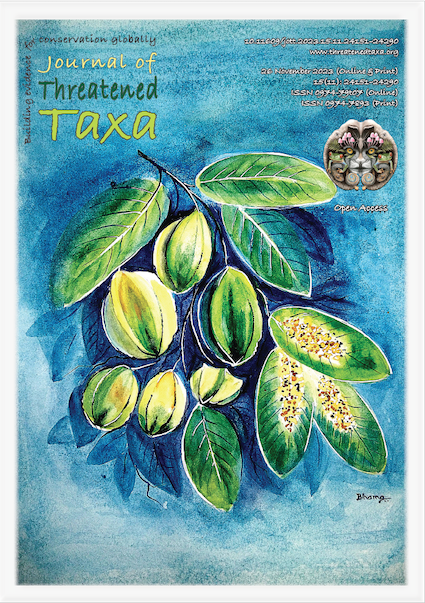Body growth and condition of endangered Tor putitora (Hamilton, 1822) (Actinopterygii: Cypriniformes: Cyprinidae) in the crucially important breeding and nursery grounds of the Ganga stock
Main Article Content
Abstract
The study evaluates seasonal differences in length-weight relationship and relative condition factor (Kn) of Tor putitora in the Nayar, a critical breeding and nursery ground in the mountain zone of the Ganga. The growth coefficient of T. putitora varies seasonally between 2.86 and 2.99 while relative condition factor between 1.00 ± 0.06 to 1.061 ± 0.3. Mahseer shows negative allometric growth (except the monsoon season) with better condition factor throughout the study period. The present Kn factor for different size groups show deviation from past which may be due inadequate of food resources or excessive fishing in the Nayar.
Article Details

This work is licensed under a Creative Commons Attribution 4.0 International License.
Authors own the copyright to the articles published in JoTT. This is indicated explicitly in each publication. The authors grant permission to the publisher Wildlife Information Liaison Development (WILD) Society to publish the article in the Journal of Threatened Taxa. The authors recognize WILD as the original publisher, and to sell hard copies of the Journal and article to any buyer. JoTT is registered under the Creative Commons Attribution 4.0 International License (CC BY), which allows authors to retain copyright ownership. Under this license the authors allow anyone to download, cite, use the data, modify, reprint, copy and distribute provided the authors and source of publication are credited through appropriate citations (e.g., Son et al. (2016). Bats (Mammalia: Chiroptera) of the southeastern Truong Son Mountains, Quang Ngai Province, Vietnam. Journal of Threatened Taxa 8(7): 8953–8969. https://doi.org/10.11609/jott.2785.8.7.8953-8969). Users of the data do not require specific permission from the authors or the publisher.
References
Ali, S., A. Barat, P. Kumar, J. Sati, R. Kumar & R.S. Haldar (2014). Study of length-weight relationship and condition factor for the Golden Mahseer, Tor putitora from Himalayan rivers from India. Journal of Environmental Biology 35(1): 225–228.
Atkore, V.M., K. Sivakumar & A.J.T. Johnsingh (2007). Length-weight relationship and relative condition factor of juvenile Golden Mahseer Tor putitora (Hamilton, 1822), in the tributaries of Ramganga river, Uttarakhand. Journal of the Bombay Natural History Society 104: 161–164.
Bhatt, J.P., P. Nautiyal & H.R. Singh (2000). Population structure of Himalayan Mahseer, a large cyprinid fish in the regulated foothill section of the river Ganga. Fisheries Research 44(3): 267–271. https://doi.org/10.1016/S0165-7836(99)00083-1
Froese, R. (1998). Length-weight relationships for 18 less-studied fish species. Journal of Applied Ichthyology 14(1–2): 117–118. https://doi.org/10.1111/j.1439-0426.1998.tb00626.x
Gupta, N., M. Everard, P. Nautiyal, I. Kochhar, K. Sivakumar, J.A. Johnson & A. Borgohain (2019). Potential impacts of non-native fish on the threatened mahseer (Tor) species of the Indian Himalayan biodiversity hotspot. Aquatic Conservation: Marine and Freshwater Ecosystems 30(2): 394–401. https://doi.org/10.1002/aqc.3275
Jha, B.R., A. Rayamajhi, N. Dahanukar, A. Harrison & A.C. Pinder (2018). Tor putitora. The IUCN Red List of Threatened Species 2018: e.T126319882A126322226. Accessed on 20 October 2021. https://doi.org/10.2305/IUCN.UK.2018-2.RLTS.T126319882A126322226.en
Johal, M.S., R.K. Negi & S. Onkar (2005). Length weight relationship of Golden Mahseer Tor putitora (Hamilton) from Pong Dam Reservoir, Himachal Pradesh. Uttar Pradesh Journal of Zoology 25(1): 85–88.
Lal, M.S. & P. Nautiyal (1980). Ecological studies on some hillstream fishes of Garhwal Himalaya 2. Length-weight relationship of Tor putitora (Hamilton). Indian Journal of Zootomy 21: 107–123.
Le Cren, E.D. (1951). The length-weight relationship and seasonal cycle in gonad weight and condition in the perch (Perca fluviatilis). The Journal of Animal Ecology 20(2): 201–219. https://doi.org/10.2307/1540
Minimol, K.C. (2000). Fishery management in Periyar Lake. PhD Thesis. Mahatma Gandhi University, Kottayam, India, 196 pp.
Nautiyal P. (1985). Observations on the length-weight relationship and relative condition factor of Garhwal Himalayan Mahseer with reference to its fishery. Indian Journal of Animal Sciences 55: 65–70.
Nautiyal, P. (1986). Studies on the riverine ecology of torrential waters in the Indian uplands of the Garhwal region III. Floristic and faunistic survey. Tropical Ecology 27: 157–165.
Nautiyal, P. (1989). Mahseer conservation: problems and prospects. Journal of the Bombay Natural History Society 86(1).
Nautiyal, P. (1996). The river valley projects in Garhwal region: Impact on the population dynamics of endangered Himalayan Mahseer with emphasis on bio conservation. Final Technical Report submitted to GDP, MOEN, New Delhi (J-11013/8/92-GDP;24-09-1992).
Nautiyal, P. (2014). Review of the art and science of Indian mahseer (game fish) from nineteenth to twentieth century: road to extinction or conservation? Proceedings of the National Academy of Sciences, India Section B: Biological Sciences 84: 214–236. https://doi.org/10.1007/s40011-013-0233-3
Nautiyal, P. & M.S. Lal (1981). Recent records of Garhwal Mahseer (Tor putitora) with a note on its present status. Journal of the Bombay Natural History Society 79(3): 593–595.
Nautiyal, P., S.N. Bahuguna & R.P. Thapliyal (2001). The role of ecological factors in governing the direction, time and purpose of migration in Himalayan Mahseer Tor putitora (Ham.). Applied Fisheries and Aquaculture 1(1): 133–138.
Patiyal, R.S., R.C. Sharma, P. Punia, M. Goswami & W.S. Lakra (2010). Length–weight relationship of Tor putitora (Hamilton, 1822) from the Ladhiya River, Uttarakhand, India. Journal of Applied Ichthyology 26(3): 472–473. https://doi.org/10.1111/j.1439-0426.2010.01466.x
Safran, P. (1992). Theoretical analysis of weight length relationship in the juveniles. Marine Biology 112: 545–551. https://doi.org/10.1007/BF00346171

